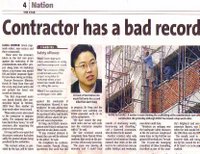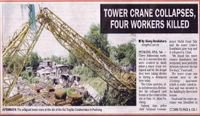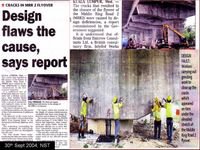
This landmark case arose out of the 1993 tragedy of the collapse of a tower block in the Highland Towers development in Ampang, just outside the Malaysian capital of Kuala Lumpur leading to loss of life and the loss of use of the Blocks that remained standing.
The event gained widespread publicity at the time, in particular as it was captured by a dramatic sequence of photographs taken by an American visitor to the Towers, and the frantic rescue operations over the next ten days.
The case has several important implications for Building Professionals in Malaysia, which will be the focus of this discussion, and also led to interesting developments and clarifications in the law of tort in Malaysia.
Brief facts
Highland Towers consisted of three blocks 12 storey high apartments named simply as Block 1, 2 and 3 respectively. It was constructed sometime between 1975 and 1978. Directly behind the 3 blocks was a steep hill with a stream flowing west (“the East Stream”), which would have passed harmlessly to the south of the Highland Towers site if it was allowed to follow its natural course.
Some time in the course of the Highland Towers development (as found by the Court) the East Stream was diverted by means of a pipe culvert to flow northwards across the hillslope directly behind Highland Towers. The approved drainage system on the hillslope behind Highland Towers was never completed.
On Saturday, the 11th December 1993, at about 1.30p.m., after 10 days of continuous rainfall, Block 1 collapsed.
The 2nd Defendant, an architectural draughtsman, was the purported architect of Highland Towers.
The Cause Of Collapse Of Block 1
In order to determine the liabilities of defendants on the allegations as charged by the plaintiffs, it is necessary at the onset to establish the cause of the collapse of Block 1 which lead to the forced evacuation Block 2 & 3. To decide on this, it is essential to disclose some brief facts.
Highland Towers & Its Surrounding Features
The retaining walls
The 3 apartment blocks of Highland Towers were built on elevated land with a relatively flat base. Directly behind it was a steep hill. Though some witnesses have describe the gradient of this hill to be 10 to 20 degrees but, by my estimate from various photographs tendered as exhibits, I perceive it to be far steeper. This hill was terraced, supported by retaining rubble walls made of boulders and cobbles of rock of varying seize placed together by mortar at a random fashion. Some of these walls had collapsed and were buried in the soil at the time of the Highland Towers tragedy. Those left are still standing, either in part or as a whole, but in a dire state of repair. From a physical survey was commissioned by MPAJ soon after the collapse of Block 1 on the affected area, covering the Highland Towers Site and the Arab Malaysian Land, it is apparent that these retaining walls were constructed in a haphazardous manner. Some were located on the Highland Towers Site with the rest in the Arab Malaysian Land.
Ownership of the slope behind Highland Towers
Both the Highland Towers Site and the Arab Malaysian Land once belonged to a common owner - the 1st defendant, who intended to develop the entire area into a housing scheme with 3 apartment blocks on Highland Towers Site and bungalows on the Arab Malaysian Land. When the lands were subdivided and issued with individual documents of title, the 1st defendant mortgaged the bungalow lots, consisting of 50 in number, to the 5th defendant in consideration of some financial arrangements. When the loans were not repaid, the 50 bungalow lots were transferred to the 5th defendant in November 1991 to offset the amount due.
The East Stream & pipe culvert
At the furthest eastern corner of the Arab Malaysian Land water from a stream, popularly known as the "East Stream" (which name is totally inappropriate since it actually flows westward), enters the 5th defendant land. The source of this stream originates from the Metrolux Land. It flows down hill in a westerly direction until it reaches a plateau where it forms a mud pond. From here the water is channeled into a set of concrete culverts which directs it to a pipe culvert (pipe culvert). This pipe culvert runs horizontally right across the hill slope of the Arab Malaysian Land. After passing through 10 bungalow lots, the water from this pipe is discharged into Lot 445 which is situated in the north. Lot 445 is a government land. This entire section of the land, as described, seems unaffected by the effects of the landslide that brought down Block 1.
The initial section of this pipe culvert was built as an integrated part of a retaining wall. It has manholes located at various intervals. Just by the side of this pipe culvert, running for some distance, is an open concrete drain. This was intended to drain surface runoff water while the pipe culvert catered for the water emanating from the East Stream.
All drainage and geo-technical experts who testified in this case agree that the flow regime of the East Stream into the pipe culvert running across the hill is highly undesirable and dangerous. Instead of water flowing along its natural course - downhill (following its natural terrain), it is now diverted into a man made structure that requires constant maintenance and supervision. Failure to attend to this will affect slope stability, causing a danger to humans living down slope. It must have been this concern that, subsequent to the collapse of Block 1, the rescue operators, upon discovering this unwarranted drainage system of the East Stream, redirected the flow pattern of this stream to its natural course, downhill in a westerly direction. They did it by placing sandbags in an area to prevent the flow of water into the pipe culvert. This is not completely successful since, by my observation during this Court's visit to the area, water is still detected in the pipe culvert.
Further down slope on the Arab Malaysian Land is network of drains. Those at the upper sector are earth drains while at the lower portion are made of concrete. These drains, I believed cater for surface water runoff while the pipe culvert was take care of the discharge emanating from the East Stream. Though in certain areas these drains are disconnected abruptly, presumably caused by the landslide that brought down Block 1, those at the upper level are still intact. But they are in an odd fashion. Starting from the top, a drain runs parallel for some distance along the pipe culvert. It then suddenly makes a U-turn to flow back in the same direction from where it came from. Then after proceeding for some distance, it is connected to a culvert across a road reserve. At this culvert and joining it is a drain coming from the opposite direction. By deduction, this drain from the opposite caters for water runoff on the southern side of the slope. From the junction the drain proceeds down hill and terminates abruptly at far right at a level parallel to the rear of Highland Towers. From an overall view of the post-collapse survey plan, this drain must have continued along the rear of Highland Towers until the end of Block 3 when it turned left down hill and drained into the lower section of the government land - Lot 445.
This drainage pattern too, in the view of all experts in the field of hydrology, is far from satisfactory. Firstly, large section of drains is earth drains that can be easily eroded. Secondly, water can infiltrate into the soil of these earth drains at a greater rate than those made of concrete. Thirdly, the flow pattern of these drains is undesirable. It does not flow naturally down hill. Instead it makes a number of U-turns, one of which even flows backwards to the direction where it came from. Fourthly, the drains are insufficient to accommodate the amount of runoff from the slope. Fifthly, the drains are in a vegetated area and maintenance is regularly and constantly required.
Before the Arab Malaysian Land was sold to the 5th defendant, Mr. Lim (DW1) was in charged of the drains on the slope. He ensured water in the drains flowed without interruptions, particularly from vegetation around it, and when the drains were damaged he would repaired it. Failure or neglect to ensure these has serious consequences as can witnessed by the flooding of the car parks at the Highland Towers accompanied by rocks and mud and a landslide on the slope some months before the collapse of Block 1. This was when Tropic moved into the Arab Malaysian Land to excavate and cleared the vegetation as well as leaving branches of trees and debris in the drains.
Bruce Mitchell's photographs
The 3 blocks of Highland Towers were built in such a manner that Block 1 and 3 were almost parallel to each other, with Block 2 in between set slightly back. From the window of the of the 4th floor of Block 3, a resident, Mr. Bruce Mitchell, had the presence of mind to snap a series of photographs just before the collapsed of Block 1. These highly commendable pictures, 6 in number, recorded the tragedy and rendered us a grime reminder of the last moments before the disaster that took so many lives and caused enormous loss of property. These pictures also provided invaluable information to specialist in the field of geo-technology to determine the cause of the collapse. They are marked as exhibit P7A - 7H but are commonly, throughout this trial, referred to as the "Mitchell Pictures".
As principal expert witnesses have relied extensively on these pictures to form their opinion, it is essential that I do give a brief description of each of these.
Photograph P7A, shows a view of the rear section of Highland Towers framed on both sides by the balconies from apartments in Block 1 & 2. At the furthest end of the picture is the hill slope. Erosion scars are seen in two areas where they are engulfed by vegetation, mainly trees which lean downhill as if being pushed by some force from above. Beneath is a rubble retaining wall. In front of this wall is a heap of earth with fragments of tar spawn over. Lower down from this spot is a continuous row of corrugated asbestos roofs in a state of collapse, with motor vehicles trapped under. Right next to this and slightly further front, is a cement slap which looks like an open-air badminton court. Supporting it is a rubble retaining wall topped by flower plants.
The left side of picture P7B shows a partial profile of Block 1 with some balconies of apartments facing Kuala Lumpur City protruding out. Beneath these is a tar-paved road with 3 motor cars parked in a row. At the far end of this road is a rubble retaining wall supporting a growth of lush green vegetation. The lower portion of this retaining wall has explored with soil spawn over a lower tier road. A lamppost standing close to the area where the soil is seen emitting has leaned.
Photograph P7C is the second frame of the same spot as P7B. The soil seen emitting in the earlier picture it is more profound. Substantial part of the retaining wall has collapsed. Greater volume of earth is seen gushing out of the disintegrated retaining wall. The lamppost has leaned more extreme.
P7D captures almost the entire Block 1 tilted at an angle with clouds of dust emitting from the base.
P7E records Block 1 almost tumbling to the ground. The rear apartments' balconies, now facing the sky are clearly visible.
P7F is a second frame of the same spot as P7E. In this subsequent shot, taken a few seconds later, there is a sea of dust with intermittent sight of a fallen building.
P7G reveals a wider view of the rear of Block 1 without the building (Block 1) obstructing. The dust from the fallen Block 1 is still present as evidenced by the white cloudily shades on the right side of the picture. In the center, starting from the top is the hill slope marked by scars extending to the right in a continuous line. Below, divided by a row of vegetation, is a rubble retaining wall which is still standing but split in the middle and slanting. In front of this is a large mess of expose earth, and floating on top are some cars with parts of the corrugated roof, which once provided a shade for the car park. At the extreme left of this photograph stands Block 2, with its landscaped terraced garden fully intact.
P7H is a pathetic view of the collapsed Block 1 lying on the ground in one piece with stunned spectators staring at the aftermath in total disbelief.
The Highland Towers Judgment -
Civil Suit No. S5-21-174-1996
The 3rd Defendant, was the engineer for Highland Towers.
The 4th Defendant was the local authority at the material time who had jurisdiction over the Highland Towers Site, the hillslope directly at the rear of Highland Towers (‘Arab Malaysian Land’) and the surrounding areas.
The 5th Defendant was, at the material time, the registered owner of the Arab Malaysian Land.
The 7th Defendant was the registered owner of a large piece of land (Metrolux Land) which is situated on top of a ridge, commonly known as Bukit Antarabangsa. This land is located just above the Arab Malaysian Land and at the material time was under development.
The 8th Defendant was the provider of management services to the 7th Defendant to develop the Metrolux Land into a housing estate.
Cause
The landslide that brought down Block 1 of Highland Towers was found by the Court to have been a rotational retrogressive slide emanating from a high retaining wall behind the 2nd of a 3-tier car park serving the 3 blocks of the Highland Towers.
Water was found to be one of the factors that caused this high wall to fail. This water emanated from poor and nonmaintained drainage, as well as a leaking pipe culvert carrying the waters of the diverted East Stream.
Liability
The following were the findings on liability by the Court:
The First Defendant was liable in negligence for not engaging a qualified architect, constructing insufficient and inadequate terraces, retaining walls and drains on the hillslope which could reasonably have been foreseen to have caused the collapse diverting the East Stream from its natural course and failing to ensure the pipe culvert diversion was adequate, and in nuisance for not maintaining drains and retaining walls.
The Second Defendant (Architect) was liable in negligence for not having ensured adequate drainage and retaining walls were built on the hillslope adjacent to the Highland Towers site, which he foresaw or ought to have foreseen would pose a danger to the buildings he was in charge of, in not complying with the requirements of the authorities in respect of drainage, in colluding with the First Defendant and Third Defendant (the Engineer) to obtain a Certificate of Fitness without fulfilling the conditions imposed by the Fourth Defendant (the Local Authority), in so doing not complying with his duties as Architect, and in not investigating the terracing of the hillslopes and construction of retaining walls even though he was aware they would affect the buildings he was in charge of, and also in nuisance as he was an unreasonable user of land.
The Third Defendant (Engineer) was liable in negligence for not having taken into account the hill or slope behind the Towers, not having designed and constructed a foundation to accommodate the lateral loads of a landslide or alternatively to have ensured that the adjacent hillslope was stable, for not having implemented that approved drainage scheme, for colluding with the First and Second Defendants to obtain a Certificate of Fitness without fulfilling the conditions imposed by the Fourth Defendant and also in nuisance as he was an unreasonable user of land.
The Fourth Defendant (Local Authority) although negligent in respect of its duties associated with building. i.e. in respect of approval of building plans, to ensure implementation of the approved drainage system during construction, and in the issue of the Certificate of Fitness, was nonetheless conferred immunity by reason of s95(2) of the Street, Drainage and Building Act.
The Fourth Defendant was however not immune in respect of its negligence in carrying out its post building functions of maintaining the East Stream. This also attracted liability in nuisance.
The Fifth Defendant (Arab-Malaysian Finance Bhd) was liable in negligence in failing to maintain the drains on its land, and in taking measures to restore stability on its land after the collapse.
The Seventh Defendant (Metrolux Properties) and its Project Manager, the Eighth Defendant, who were liable in negligence and nuisance for preventing water from flowing downhill (into their site) and instead directing water into the East Stream, when they knew or ought to have known that this would increase the volume of water and inject silt, especially where there was extensive clearing on their land, into the East Stream where it would be deposited, which would in turn (as proved) cause or contribute to the failure of the drainage system and collapse of Block 1.
The Ninth and Tenth Defendants (essentially the State Government) were not found liable due to a technical issue in respect of the particular party sued.
The Sixth Defendant (an abortive purchaser of the Arab-Malaysian Land who carried out site clearing works) was not found liable on the evidence.
Impact On Duties Of Building Professionals
A. The Architect
(i) No Defence That Engagement Was A Limited One, At The Very Least Must Ensure The Other Aspects Of The Works By Others Was Done Competently
The Architect’s defence that he was only retained to design and supervise the 3 apartment blocks, and denied that his scope extended to the drainage, earthworks and retaining walls.
This was rejected by the Court.
The Court held that the Architect must take into account the condition of the vicinity of the land upon which the building is built, as well as the land itself, must be evaluated when assessing the safety of the building.
[Also, as a matter of fact the Court found that the Architect was concerned with the vicinity as well as the building itself when he submitted the layout plan to the authorities as it included terracing and drainage of the hillslope behind Highland Towers. He must therefore ensure that this work, although carried out by others, is carried out in a competent and workmanlike manner]
(ii) No Difference In Standard Of Care For Unqualified Practitioner
Even though the Architect was in reality only an Architectural draughtsman, the Court measured his conduct against the standard of a reasonably competent Architect, holding that if a man is unqualified but holds himself out to be possessing a skill, he would be judged by the standard of a reasonably competent qualified person.
(iii) No Excuse To Say That Employer Forced Non- Compliance With Laws
Finally, the Court appears to have emphatically rejected the excuse of the Architect that he could not stop his boss from doing anything (in the context of colluding with the employer and engineer in obtaining Certificates of Fitness for the three apartment blocks without fulfilling the conditions imposed by the Local Authority and not ensuring the terracing and retaining wall were properly designed, provided for and sufficient to withstand slope failure even though he was aware it would affect the buildings he was in charge of) – the Court has clearly stated that when the law is broken, the Architect must report to the authorities – the architect must ensure that the law is followed even at the risk of being discharged.
B. The Engineer
The Engineer’s defence that he was only retained to design and supervise the structural aspects of the 3 apartment blocks, two retaining walls within the Highland Towers compound and submit plans for the drainage and two and denied that his scope extended to the drainage, earthworks.
This was rejected by the Court
The Court held that the Engineer must take into account the condition of the vicinity of the land upon which the building is built, as well as the land itself, must be evaluated when assessing the safety of the building. He should have ensured the stability of the hillslope behind Highland Towers.
His duty was not discharged by a mere belief that the terracing of the hillslopes and the retaining walls built on them were carried out by an engineer or other consultant. He ought to have inquired as to
whether this professional was qualified, and
whether what he was doing affected the safety of the Tower Blocks.
[Other Aspects of the Engineer’s negligence – gross violation of his duty of care to the purchasers in the issue of a notification to the Authorities that the approved drainage was built when only 10% was built]
Summary
Building Professionals require to consider the vicinity of the site as well as the site itself in assessing safety-particularly in regard to adjacent hillslopes.
Building Professionals cannot hide behind limited scopes of engagement-these are a matter between themselves and their employer, but the scope of their duty owed to persons likely to be affected by their services is not so limited.
Building Professionals require to ensure that others engaged to do work likely to affect the structures they have been engaged to design/supervise are competent and will carry out their work in a workmanlike manner.
If Building Professionals hold themselves out to have expertise in a particular area when they are unqualified, their conduct will be measured against the ordinarily competent qualified practitioner of such expertise.
Building Professionals must ensure the law is followed, reporting to the authorities if necessary if their clients break the law, even at the risk of being discharged by their client.
Impact On Tort Law
Negligence
The Highland Towers decision becomes another Malaysian High Court decision which diverges from the approach of the English Courts and adopts the approach taken by other Commonwealth jurisdictions in allowing the recovery of “pure economic loss”, especially where sufficient proximity can be demonstrated between the negligent act and the loss. Pure economic loss is the loss related to the product itself which is defective by reason of negligence, as opposed to the loss or damage caused to the property of the Plaintiff by this defective product.
Nuisance
In this cause of action, a Defendant is liable if the Plaintiff can show the Defendant is responsible for a condition or activity which interferes with use or enjoyment of his land, and that condition or activity is not a reasonable user by the Defendant. The Highland Towers decision extends the law on nuisance in Malaysia by requiring an additional requirement to be established by the Plaintiff, i.e. whether the damage was of type that the Defendant could reasonably foresee, adopting a principle from an English case, Cambridge Water Co. Ltd v Eastern Countries Leather plc [1994] 1All ER 53 @ 70.
Rule In Rylands v Fletcher
In this cause of action, if a person brings unto his land and collects and keeps anything to do with mischief and it escapes, he is answerable prima facie for all the damage which is the natural consequence of the damage, regardless of whether the Defendant was negligent or not. The Highland Towers decision, following the Australian High Court in Burnie Port Authority v General Jones Pty Ltd 120 ALR 42 abandoned this as an independent cause of action and merged it into the general law of negligence.
Conclusion
In conclusion, the Highland Towers decision clarifies the extent and nature of the professional duties and responsibilities of Building Professionals demanded by the law, and contains important developments in tort law in Malaysia.
It remains to be seen if the Appellate Courts in Malaysia will endorse these principles.
The Judgments
Dr Benjamin George & Ors v Majlis Perbandaran Ampang Jaya and other applications
[1995] 3 MLJ 665
HIGH COURT (SHAH ALAM) — ORIGINATING MOTION NOS 25–42–94, 25–41–94 AND 25–39–94
FAIZA TAMBY CHIK J
3 OCTOBER 1995
Summary
The applicants in this case were the developer and several residents and purchasers of blocks two and three of the Highland Towers Condominium (‘the Highland Towers’). The respondent was Majlis Perbandaran Ampang Jaya (‘the MPAJ’). The MPAJ had issued notices pursuant to s 83 of the Street, Drainage and Building Act 1974 (‘the Act’) to the applicants, which had the effect of ordering them to either repair or demolish blocks two and three of the Highland Towers and the walls on the nearby hillslopes, within three months from the date of the notices. The directions in the notices were contrary to the recommendations proposed by the Highland Towers committee, which was set up by the respondent to study the safety of blocks two and three, immediately after the collapse of block one of the Highland Towers. The applicants had actively tried to sought a solution to the Highland Towers problem, but the respondents refused to discuss the legality of the s 83 notices. This clearly ruled out any possibility that the respondent would withdraw the s 83 notices. Therefore, the applicants applied to the High Court for certiorari via O 53 of the Rules of the High Court 1980, to quash the notices on the grounds, inter alia, that the notices were unreasonable, unconstitutional, and illegal. However, the respondent argued that it had acted within its jurisdiction, and that the s 83 notices were not amenable to certiorari, as alternative appeal procedure had been provided by ss 83(3), (6), 91 and 92 of the Act.
Holdings
Held, allowing the application:
(1) Section 83(1) of the Act confers a broad discretion on a local authority by allowing it to issue a s 83 notice after conducting such inquiry as it thinks fit to satisfy itself that a building is in a dangerous condition. A notice may require the owner of the building to either repair the defects or demolish the building within such period of time as it may specify. However, this discretion must be exercised in good faith, for a proper purpose, and after consideration of all the relevant factors. Further, a s 83 notice can only be directed to an ‘owner’ of a building as defined in s 3 of the Act.
(2) Both s 83(3) and (6) of the Act are not appeal provisions, as neither provides recipients of the s 83 notices with an opportunity to appeal to a higher authority against the validity of the notices. Thus, there is nothing in s 83 which provides them with an alternative statutory appeal procedure in preference to certiorari. Similarly, ss 91 and 92 also do not provide a genuine appeal procedure, as a right of appeal under the provisions only arises against a mandatory order made by the magistrates’ court. This would mean that the recipients of the s 83 notices could only appeal if the respondent had seeked for the mandatory order.
(3) An administrative decision which has failed to give adequate weight to a relevant factor of great importance or has given excessive weight to a factor of no great importance could be set aside on the ground of unreasonableness In this case, it was impossible to comply with the s 83 notices, because it was irrational to expect the applicants to do repairs on the hillslopes which they did not own, and which would have amounted to committing a trespass. Besides, three months was a wholly inadequate time period to carry out the repair or demolition works.
(4) Moreover, the directions in the notices departed from the recommendations of the Highland Towers committee, without giving any reason or explanation. This amounted to a breach of legitimate expectation rendering the s 83 notices ultra vires.
(5) Pursuant to the Act, the s 83 notices can only be served on the owner of the relevant building. In this case, as the strata titles of the Highland Towers had not been issued, the registered proprietor of the land, ie the developer, would be the owner. However, the respondent had issued the s 83 notices to the residents of the Highland Towers who were not owners for the purposes of the Act. Even if they were the owners, the s 83 notices were still ultra vires as they were not issued to all ‘owners’ of these buildings, contrary to art 8 of the Federal Constitution which states that all persons are equal before the law.
(6) Highland Properties Sdn Bhd, who was the owner for the purposes of the Act, had a duty to implement the views of the purchasers of blocks two and three of the Highland Towers. In turn, by virtue of the express and implied obligations imposed in the sale and purchase agreements between the developer and the purchasers, the purchasers might have to make contributions in order to comply with the s 83 notices. The s 83 notices must also be served on the financial institutions who had granted loans to the purchasers, as the purchasers had already assigned their rights under the sale and purchase agreements to them.
(7) It was clear that there was a failure on the part of the respondent to comply with the express and implied limitations on their statutory discretion in this case. The s 83 notices, which were illegal, had the potential to deprive the residents of blocks two and three of the Highland Towers of their apartments should the blocks be demolished. This was also contrary to art 13 of the Federal Constitution which provides that no person shall be deprived of property save in accordance with law.
Steven Phoa Cheng Loon & Ors v Highland Properties Sdn Bhd & Ors
HIGH COURT (KUALA LUMPUR) — CIVIL SUIT NO S5–21–174 OF 1996
JAMES FOONG J
11 AUGUST 2000
Summary
Highland Towers, constructed sometime between 1975 and 1978, consisted of three blocks 12-storey high apartments named as Block 1, 2 and 3 respectively. Directly behind the three blocks was a rather steep hill with a stream (‘the east stream’). On 11 December 1993, Block 1 collapsed. Immediately after the collapse of Block 1, the residents of Block 2 and 3 were prevented from entering their apartments by the local authority for fear of the instability of these two buildings. The purchasers/owners of Block 2 and 3 issued a writ against ten defendants: the first defendant was the developer of the three apartment blocks; the second defendant was the purported architect of Highland Towers; the third defendant was the engineer of Highland Towers; the fourth defendant was the local authority who had the jurisdiction over the Highland Towers site and the surrounding areas; the fifth defendant was the registered owner of 50 lots of bungalow land (‘the Arab Malaysian land’) directly at the rear of Highland Towers; the sixth defendant (Tropic) was a company that carried out clearing works on the Arab Malaysian land; the seventh defendant was the registered owner of a piece of land (‘the Metrolux land’) situated on top of a ridge just above the Arab Malaysian land and at the material time was under development; the eight defendant was the provider of management services to the seventh defendant to develop the Metrolux land; the ninth defendant was the state government of Selangor; and the tenth defendant was the Director of Land and Mines of the State of Selangor.
The plaintiffs’ claim was for damages caused jointly and/or severally by the acts and/or omissions of the defendants, their servants and/or agents in causing and/or contributing to the collapse of Block 1 and thereby forcing the plaintiffs to evacuate and abandon Block 2 and 3. The cause of action relied on by the plaintiffs against the defendants were negligence, nuisance and the liability under Rylands v Fletcher.
There were two conflicting theories advanced on the cause of the failure of Block 1. Supporting the plaintiffs’ contention was Dr Weeks and on the side of the fifth defendant was Prof Simons. The significance of these two theories was the belief that it would affect the liabilities of the parties, particularly of the first and fifth defendant. If Dr Weeks’ version was accepted, then it was contended that the cause of failure emanated from the fifth defendant’s land. Professor Simons, on the other hand, insisted that it originated form the first defendant’s property.
The defendants raised the following preliminary issues: (i) plaintiffs 44 to 73 had no right to bring the action against the defendants by virtue of s 4(3) of the Civil Law Act 1956 since their rights had been assumed by the financial institutions in favour of which a loan agreement cum assignment had been executed; and (ii) the claim of the plaintiffs could not be maintained because it was a claim for pure economic loss, the two apartments being the defective products.
The ninth and tenth defendants raised the following preliminary points: (i) citation of the wrong party — the ninth defendant should be the State Director; and (ii) particular officer or officers not named — by the provision of ss 5, 6(1), 6(4) and 18 of the Government Proceedings Act, the particular officer or officers in the government who committed the tortuous wrong must be identified, otherwise the claim against the tenth defendant must fail.
Holdings
Held:
(1) With recognition by such high authority of such loan agreement cum assignment to be an equitable charge, the court saw no reason why the word ‘charge’ in s 4(3) of the Civil Law Act should not include equitable charge of this nature. For after all, this equitable charge was specie of a charge. Thus when this instrument of assignment purported to be by way of a charge, the effect of s 4(3) of the Civil Law Act was no longer applicable. Further, after perusing the loan agreements cum assignments, the court could not interpret them to be absolute assignments by the plaintiffs to the financial institutions. Though the word ‘absolute’ appeared in the documentation of the loan agreements cum assignments, there were also other clauses to show that the rights and interests in the sale and purchase agreements so assigned have not been transferred to the assignors. Besides, by the principle of equity of redemption, the plaintiffs were also able to maintain their right to sue (see pp 220G–221A, F).
(2) After due consideration, the court was more inclined to adopt Prof Simons’ interpretation that the landslide that brought down Block 1 of Highland Towers was a rotational retrogressive slide emanating from the High Wall behind the second tier car park. The court found that water must have been a major factor in causing the collapse of the high wall and the landslide that followed (see pp 234G, 235D).
(3) When the second defendant had represented himself as a qualified architect to all and sundry, as displayed by his actions, then he must be judged according to the character he had assumed. At the time when this defendant exercised his duty as an architect for the Highland Towers project, he must have foreseen that the apartments he built would be sold, and purchasers, their servants and/or agents would be occupying them. Thus these purchasers would be closely and directly affected by his acts and/or omissions and for this, he must have or ought to have them in contemplation when he was directing his mind to his acts and/or omissions. By this, the court found a duty of care existed between the second defendant and the plaintiffs and from the facts of the case, it was obvious that the second defendant had breached his duty of care to the plaintiffs (see pp 241A, C–E, 243C).
(4) When you had a hill so close and acute then the third defendant should have reasonably foreseen, judging by professional standard as an engineer responsible for the structure of Block 1, the danger of a landslide producing a lateral load against the foundation of the building. For this, he should have exercised care to either design and construct a foundation to accommodate lateral load or ensure that the slope was reasonably stable. Failure to do so was a breach of his duty of care he owed to the plaintiffs since his duty was to ensure the safety of the buildings he designed and built (see p 246G–H).
(5) As a general rule, an employer of independent contractor is not liable for the default or negligence of such a contractor. But here the plaintiffs were focusing on the appointment of such personalities, not after they were appointed. This means that before their appointment, there was a duty placed upon the first defendant to vet through them to ensure that they were competent and possessed such skill for the task they were employed to undertake. This involved inquiries and investigations into their credentials and qualifications. Obviously, these were not done. Despite being notified by the second defendant that he was not a qualified architect, the first defendant proceeded to engage him and even allowed him to appoint the third defendant as the consultant engineer for the project. This was surely negligent on the part of the first defendant (see pp 248H–249B).
(6) When implementing works of terracing of the slope and construction of retaining walls and drains on both the Arab Malaysian land and the Highland Towers site, the first defendant must have reasonably foreseen that such works, if insufficient and ineffective, would cause the collapse of Block 1 and result in damages to the plaintiffs, who were its neighbours under the principle of negligence. The retaining walls and the drainage system had been proved to be insufficient and inadequate. The court must conclude that the first defendant had breached his duty of care to the plaintiffs (see p 249B–E).
(7) Like the second and third defendants, the first defendant was liable for nuisance as one of the creators of the nuisance by its acts and/or omissions. Further, as an owner of the Highland Towers site, it had not been a reasonable user of its land for it failed to maintain the drainage system and the retaining walls resulting in the damages suffered by the plaintiffs who were its neighbours (see p 251B–C).
(8) Judging from the facts as disclosed in the chronology of events, the fourth defendant was negligent of the wrongs as alleged by the plaintiffs. However, since the acts of the fourth defendant were within those specified activities under s 95(2) of the Street, Drainage and Building Act, immunity applied to the fourth defendant (see pp 252H, 255E–F).
(9) However, the immunity did not apply to the fourth defendant for acts/omissions committed post-collapse. Despite the pressing need and the obvious knowledge of the urgent requirement for a master drainage plan to secure the stability of the slope so as to ensure the safety of the two apartment blocks, the fourth defendant did nothing. This was certainly inexcusable and definitely a breach of duty of care owed by the fourth defendant to the plaintiffs (see pp 256H–I, 259A–B).
(10) By the acts and/or omissions of the fourth defendant, the court also found that the fourth defendant was an unreasonable user of its land in failing to maintain the stream post-collapse which was under its care. Its acts and/or omissions were foreseeable to cause a damage to the plaintiffs — its neighbours. For this, the court found the fourth defendant was also liable to the plaintiffs for nuisance (see p 259E–F).
(11) Since it was already decided that it was due to a landslide caused primarily by water which emanated from the damage pipe culvert and the inadequate and unattended drains on the fifth defendant’s land, then the plaintiffs had sufficiently proved that the causa causan of the collapse of Block 1 leading to the forced evacuation of the plaintiffs from Block 2 and 3 was due to the acts and/or omissions of this defendant in not maintaining these water-courses. From the factual circumstances as disclosed, the court found that the fifth defendant could reasonably foresee that by its acts and/or omissions in failing to take care of its land, it would cause a land slide that would destroy Block 1 and forced the abandonment of Block 2 and 3 (see pp 261H–I, 262C–D).
(12) Given the circumstances of this case and applying the common law principle to nuisance, the court was convinced that the fifth defendant caused an actionable nuisance to the plaintiffs (see p 267B–C).
(13) Judging by the facts, the court did not find that the sixth defendant was negligent or committed nuisance. There was no evidence advanced to link the acts of this defendant in excavating and clearing Arab Malaysian land to the cause of the landslide that tumbled Block 1 (see p 268C–D).
(14) The assertion of the seventh and eight defendants during submission that they should not be made responsible for the acts of their independent contractors was an after thought for it was never pleaded in the statement of defence. Further, even if this issue was allowed to be raised, the defendants were not exempted from the liabilities for the acts of their independent contractors. The factual situation in the present case showed that it fell within the exception to the general rule, ie non-delegable duty covering cases involving extra hazardous acts or omissions (see pp 276G, 277D–E).
(15) As property developer and/or manager of development projects on a hill, the seventh and eight defendants must have known or ought to have known that by diverting watercourses on their land to the east stream, they would increase the volume of discharge to this outlet. With an extensive area of their land denuded of trees, they must have foreseen that water flowing over this area would carry with it eroded soil and silt which would be deposited down stream. And as proved, these caused or contributed to the collapse of Block 1 and forced evacuation of Block 2 and 3 (see p 280F–G).
(16) In the factual matrix of this case, the water at the Metrolux site was naturally on the land but the defendants had artificially erected barriers on their land to redirect its natural flow path into the east stream which consequently caused the damage suffered by the plaintiffs. Such acts of the defendants were closely and directly connected to the damage and for this, the seventh and eight defendants must be liable to the plaintiffs (see p 281H).
(17) For the purpose of this case, in respect of claims arising out of rivers, streams or watercourses, very little difference was made since the State Director, who was the tenth defendant, was already a party to this action. However concerning matters arising out of the ownership and/or occupier of the surrendered lands, the situation was different. The plaintiffs had not in their pleadings alleged that the tenth defendant was the person being sued this particular aspect of the claim. The plaintiffs’ statement of claim repeatedly and distinctively asserted that the tenth defendant was brought in as a party to this suit ‘by virtue of the fact that the property in stream and watercourses on Arab Malaysian land and its surrounding was vested in the state authority of Selangor’; never as a State Director to the surrendered lands. Thus, the claim of the plaintiffs against the ninth defendant must failed in respect of drainage matters but maintainable against the tenth defendant. But for the surrendered lands, the plaintiffs’ claim must fail against both defendants (see pp 284G–285A).
(18) The statutory provision implies a need to identify and distinguish the officer or officers concerned before the plaintiffs can proceed with attributing liability to the government. In the situation at hand, only the drainage and irrigation department was named in respect of matters related to drainage. Such defects were too serious and fundamental for such proceedings against the government to succeed; it must fail for non-compliance of the legislative provisions laid down for such action against a state government. By this, the plaintiffs’ claim against the ninth and tenth defendants must fail (see p 287A–D).
(19) On the issue of ‘pure economic loss’, following Dr Abdul Hamid Abdul Rashid & Anor v Jurusan Malaysian Consultants [1997] 3 MLJ 546, the court held that claim for pure economic loss can be maintained against the defendants (see p 244H).
(20) From the evidence tendered, the court was without doubt that all defendants, except number sixth, ninth and tenth, were joint tortfeasors in causing the same damage to the plaintiffs. For this, contribution could be recovered from each other (see p 288A).
References:Malaysian Law Journal
http://www.lawyerment.com.my/library/doc/laws/casecode/jdgm/11082000-01-3.shtmlhttp://www.trett.com/digest/doit.asp?iss=27&art=4UPDATED REPORT: 18th February 2006
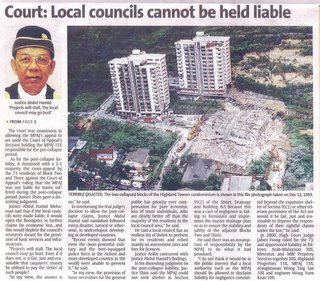
From the principles laid down in the Court of Appeal judgment, the Highland Towers decision clarifies the extent and nature of the professional duties and responsibilities of Building Professionals demanded by the law, and contains important developments in tort law in Malaysia.
Howeve this decision of the Court of Appeal remains subjected to the Highest Court, i.e. the Federal Court, whether they would endorse these principles.
Final Judicial DecisionToday, 18th February 2006 frontpage headline the Federal Court's Decision
Federal Court: MPAJ has full immunity from claimsLocal councils cannot be held liable for losses suffered by anyone should a building collapse, the Federal Court has ruled. The court said this when it held that the Ampang Jaya Municipal Council (MPAJ) was not liable for losses suffered by 73 residents of two blocks of the Highland Towers condominium who had to evacuate after the collapse of Block One 13 years ago, killing 48 people.
The three-member panel presided by Chief Judge of Sabah and Sarawak Justice Steve Shim Lip Kiong and Federal Court judges Datuk Abdul Hamid Mohamed and Datuk Arifin Zakaria ruled that the MPAJ was not liable in the pre-collapse period as well as post-collapse period of Block One. They said local authorities such as the MPAJ were given full immunity under Section 95 (2) of the Street, Drainage & Building Act 1974 (Act 133) from claims for the pre-collapse period.
The court was unanimous in allowing the MPAJ’s appeal to set aside the Court of Appeal’s decision holding the MPAJ 15% responsible for the pre-collapse period. As for the post-collapse liability, it dismissed with a 2-1 majority the cross-appeal by the 73 residents of Block Two and Three against the Court of Appeal’s ruling that the MPAJ was not liable for losses suffered during the post-collapse period.
Justice Shim gave a dissenting judgment.
Justice Abdul Hamid Mohamad said that if the local councils were made liable, it would open the floodgates to further claims for economic loss, and this would deplete the council’s resources meant for the provision of basic services and infrastructure. “Projects will stall. The local council may go bust. Even if it does not, is it fair, just and reasonable that taxpayers’ money be utilised to pay the ‘debts’ of such people? In my view, the answer is no,” he said.
In overturning the trial judge’s decision to allow the post-collapse claims, Justice Abdul Hamid said vandalism followed every disaster, natural or otherwise, in undeveloped, developing or developed countries. “Recent events showed that even the most-powerful military and the best-equipped police force in the richest and most-developed country in the world were unable to prevent it,” he said.
“In my view, the provision of basic necessities for the general public has priority over compensation for pure economic loss of some individuals, who are clearly better off than the majority of the residents in the local council area,” he said.
He said a local council has an endless list of duties to perform for its residents and relied mainly on assessment rates and fees for licences.
Justice Arifin concurred with Justice Abdul Hamid’s findings.
In his dissenting judgment on the post-collapse liability, Justice Shim said:
"The MPAJ could not seek shelter in Section 95(2) of the Street, Drainage and Building Act because this was a case of negligence in failing to formulate and implement the master drainage plan so as to ensure the stability and safety of the adjacent Blocks Two and Three."
He said there was an assumption of responsibility by the MPAJ to do what it had promised.
“I do not think it would be in the public interest that a local authority such as the MPAJ should be allowed to disclaim liability for negligence committed beyond the expansive shelter of Section 95(2) or other relevant provisions of the Act nor would it be fair, just and reasonable to deprive the respondents of their rightful claims under the law,” he said.
In 2000, High Court Judge James Foong ruled for the 73, and apportioned liability as follows: Arab-Malaysian 30%, Metrolux and MBf Property Services together 20%, Highland Properties 15%, MPAJ 15%, draughtsman Wong Ting San 10% and engineer Wong Yuen Kean 10%.
ConclusionThe case is put to rest. The local authorities received the legal mandate that they are fully immune to liabilities. Even in committing reckless negligence, they will be shielded by the law under Section 95(2). Presumably, they could be care-free in all their ways of doing things and approving anything they deem fit in their full discretion, without the need to consider any threats to life, or to others.
It is the sad day for the Rule of Law in Malaysia.
Only if, and only if, we still can take the case to the UK Privy Council, can be hope to seek natural justice and the fundamental Rule of Law.
I Cry for You, Malaysia!!!





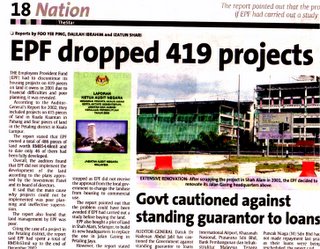




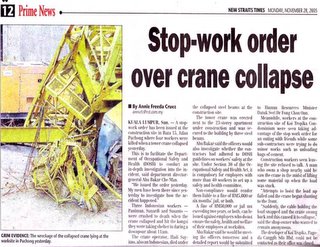





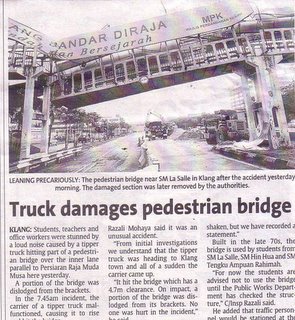



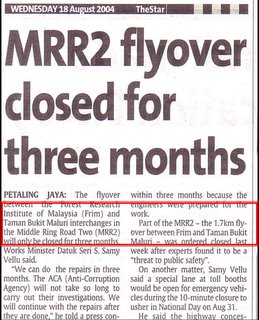





 Halcrow has found a rare phenomenon--the expansion of a chemical compound, ettringite, had caused serious cracks. The compound contains calcium, aluminium, oxygen, sulphate, water, etc. On 25 February, 2005, Halcrow recommended to JKR to waterproof the bridge immediately, so that the delayed ettringite formation (DEF) would not result in further cracks.
Halcrow has found a rare phenomenon--the expansion of a chemical compound, ettringite, had caused serious cracks. The compound contains calcium, aluminium, oxygen, sulphate, water, etc. On 25 February, 2005, Halcrow recommended to JKR to waterproof the bridge immediately, so that the delayed ettringite formation (DEF) would not result in further cracks.

